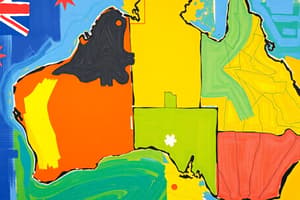Podcast
Questions and Answers
What was the primary purpose for the British colonizing Australia in the early 1800s?
What was the primary purpose for the British colonizing Australia in the early 1800s?
- Searching for gold
- Establishing trade routes
- Exploring uncharted territories
- Base for military operations and a penal colony (correct)
The first area where prisoners were sent in Australia later became the town of Melbourne.
The first area where prisoners were sent in Australia later became the town of Melbourne.
False (B)
How long did the indigenous Aborigines live in Australia before the arrival of Europeans?
How long did the indigenous Aborigines live in Australia before the arrival of Europeans?
Over 40,000 years
The systems established for the survival of convicts in Australia allowed them to grow their own _____ and run their own businesses.
The systems established for the survival of convicts in Australia allowed them to grow their own _____ and run their own businesses.
Match the following events with their corresponding outcomes or effects:
Match the following events with their corresponding outcomes or effects:
What percentage of Aborigines were estimated to have been killed as a result of British colonization?
What percentage of Aborigines were estimated to have been killed as a result of British colonization?
The last convicts in Australia arrived in 1868.
The last convicts in Australia arrived in 1868.
What were the strict controls placed on the lands allocated for the Aborigines called?
What were the strict controls placed on the lands allocated for the Aborigines called?
What was one outcome of the Aborigines being forced onto reserves?
What was one outcome of the Aborigines being forced onto reserves?
The Gold Rush in the 1850s led to the Aborigines being treated as valued workers.
The Gold Rush in the 1850s led to the Aborigines being treated as valued workers.
What term was used to describe the belief that Aboriginal people were inferior and would become extinct?
What term was used to describe the belief that Aboriginal people were inferior and would become extinct?
The 1901 Immigration Act was aimed at maintaining a __________ population in Australia.
The 1901 Immigration Act was aimed at maintaining a __________ population in Australia.
Which policy was established to encourage European immigration to Australia?
Which policy was established to encourage European immigration to Australia?
Match the following terms with their descriptions:
Match the following terms with their descriptions:
The dictation test required non-Europeans to demonstrate language proficiency in any chosen European language.
The dictation test required non-Europeans to demonstrate language proficiency in any chosen European language.
What was the impact of the Gold Rush on white farmer populations?
What was the impact of the Gold Rush on white farmer populations?
What policy was abandoned by eugenics' supporters?
What policy was abandoned by eugenics' supporters?
After WW2, a significant number of orphaned British children were sent to Australia with parental consent.
After WW2, a significant number of orphaned British children were sent to Australia with parental consent.
What was one outcome for many children sent to Australia after WW2?
What was one outcome for many children sent to Australia after WW2?
The plan to keep Australia racially 'pure' involved improving the ______ stock through selected breeding.
The plan to keep Australia racially 'pure' involved improving the ______ stock through selected breeding.
Match the following events with their descriptions:
Match the following events with their descriptions:
What was the response of eugenics supporters to the idea of white mothers being rewarded for having children?
What was the response of eugenics supporters to the idea of white mothers being rewarded for having children?
Many Japanese women who married Australians were deported after WW2.
Many Japanese women who married Australians were deported after WW2.
How did the children sent from Britain to Australia generally fare?
How did the children sent from Britain to Australia generally fare?
What was the primary goal of the policy of assimilation concerning ‘half caste’ children?
What was the primary goal of the policy of assimilation concerning ‘half caste’ children?
The Stolen Generation refers to Aboriginal individuals who were willingly integrated into white culture.
The Stolen Generation refers to Aboriginal individuals who were willingly integrated into white culture.
Who were AO Neville and Dr. Cecil Cook?
Who were AO Neville and Dr. Cecil Cook?
The policy of assimilation aimed to breed out Aboriginal _____.
The policy of assimilation aimed to breed out Aboriginal _____.
What was one consequence faced by the children of the Stolen Generation?
What was one consequence faced by the children of the Stolen Generation?
What is miscegenation?
What is miscegenation?
Match the following key figures with their roles:
Match the following key figures with their roles:
The policies directed at the Aborigines resulted in their cultural preservation.
The policies directed at the Aborigines resulted in their cultural preservation.
Flashcards are hidden until you start studying
Study Notes
Early History of Australia
- Indigenous Australians, the Aborigines, lived in Australia for over 40,000 years before European arrival.
- They were nomadic hunter-gatherers and culturally diverse, with many different languages.
British Colonization
- British colonization began in the early 1800s.
- Australia was used as a military base and a penal colony.
- The first area prisoners were sent became Sydney.
- Convicts were mostly from the working class, convicted of minor crimes.
- Unlike in Britain, they were not jailed but lived in villages, working on government projects and growing their own food.
- The last convicts arrived in 1868.
Effects of British Colonization
-
British:
- The colony prospered as gold mining and agriculture developed.
- In 1901 colonists formed a federation called Australia, with states self-governing but overseen by a federal government (similar to the USA).
- Settlers brought with them pseudo-scientific ideas popular in Europe at the time.
-
Aborigines:
- About 80% were killed by hunting, conflict with settlers, and diseases like smallpox.
- As white settlements spread, remaining Aborigines were pushed onto the land, forced to live in the desert outback.
Aboriginal Reservations
- The British government and humanitarians became concerned with the treatment of Aborigines.
- They created reserves, known as stations, missions, or reserves, for Aborigines to live on.
- These reserves were strictly controlled by the government's Aborigines' Protection Board.
- About 200 reserves were established throughout Australia.
- As Aborigines had no land rights, they could be forced to live and remain on these reserves against their will.
- Aborigines on reserves were unable to maintain their traditional nomadic lifestyle as hunters and gatherers.
- This led to starvation and widespread alcoholism on reserves.
- There were conflicts between Aborigines and farmers due to raiding of livestock.
- The laws regarding reserves were not strictly applied in some areas, but those living outside them faced discrimination and prejudice.
The Gold Rush
- during the 1850s Gold Rush, many white farmers left to find gold, making the Aborigines a crucial source of labor.
- Aborigines were effectively treated like slaves, receiving basic necessities like food and clothing in exchange for their work.
Fear of 'Racial Suicide'
- Some white Australians believed the small and slow-growing population was threatened by:
- The remaining Aborigines.
- The rapidly expanding population of Asian countries to the north of Australia.
White Australia Policy and Eugenics
- To prevent 'racial suicide', the White Australia policy was introduced in 1901.
- The Immigration Act required prospective immigrants to pass a dictation test in any European language chosen by the officer.
- This effectively excluded non-Europeans and denied them the right to live in Australia.
- In 1920, a Minister for Motherhood was appointed to boost the white population.
- Plans for financial incentives for white mothers having children were abandoned due to concerns about encouraging 'inferior' stock to breed.
- Eugenics supporters believed 'unfit' members of society should be prevented from having children through separation or sterilization.
Post-WW2 Immigration
- Adults from Britain were encouraged to emigrate to boost the white population and reduce unemployment in the UK.
- During WWII, many non-white refugees entered Australia, fleeing Asia.
- Most left after the war, but efforts to deport those married to Australians (mainly Japanese women) were resisted, and they were allowed to stay.
- After the war, over 10,000 orphaned or destitute children from Britain were sent to Australia without parental consent.
- Many were separated from their families and falsely told they were orphans.
- They were often mistreated in institutions or by farmers, facing physical and sexual abuse, malnutrition, and slave labor.
- This policy was supported by both the British and Australian governments, and has been described as disgraceful.
Preventing 'Racial Decay'
- The policy aimed to keep Australia racially 'pure' by encouraging 'scientifically' controlled selective breeding and preventing 'inferior' groups from reproducing.
- It was believed pure Aborigines would die out naturally due to their small numbers, but the problem of 'half-castes' (children of white and Aborigine parents) remained.
The Stolen Generation
- In 1915, A.O. Neville and Dr. Cecil Cook oversaw the policy of assimilation.
- Thousands of children of mixed race were forcibly removed from their families.
- They were cut off from their Aboriginal culture, intended to force them to embrace a 'white' lifestyle.
- Many children were put into foster homes or institutions and suffered abuse.
- They were often trained as domestic servants or laborers.
- Miscegenation (interracial breeding) was permitted as a way to 'breed out' Aboriginal blood.
'History Wars'
- There is much controversy surrounding the interpretation of the Australian government's policies.
- Genocide: Critics argue that the deliberate extermination of Aborigines was intentional, given the high death rates.
- Comparison to Nazi Eugenics: There is debate over whether the assimilation policy was comparable to Nazi eugenics:
- Miscegenation contradicts the eugenic concept of breeding 'the best with the best'.
- Neville and Cook believed assimilation would increase the 'white' population, prevent conflict, and promote equal citizenship.
- They also hoped that Aboriginal blood might help overcome problems facing white Australians in the tropics, such as skin cancer.
Conclusion
- The Australian government's policies towards Aborigines nearly resulted in their biological and cultural extinction.
Studying That Suits You
Use AI to generate personalized quizzes and flashcards to suit your learning preferences.




